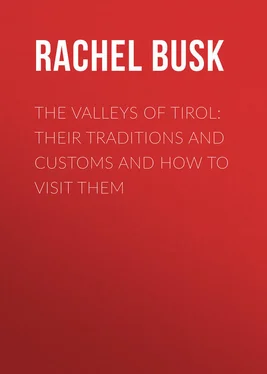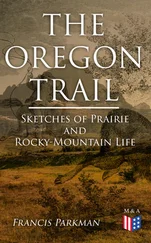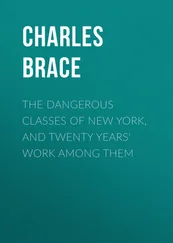Rachel Busk - The Valleys of Tirol - Their traditions and customs and how to visit them
Здесь есть возможность читать онлайн «Rachel Busk - The Valleys of Tirol - Their traditions and customs and how to visit them» — ознакомительный отрывок электронной книги совершенно бесплатно, а после прочтения отрывка купить полную версию. В некоторых случаях можно слушать аудио, скачать через торрент в формате fb2 и присутствует краткое содержание. Жанр: foreign_antique, foreign_prose, Путешествия и география, на английском языке. Описание произведения, (предисловие) а так же отзывы посетителей доступны на портале библиотеки ЛибКат.
- Название:The Valleys of Tirol: Their traditions and customs and how to visit them
- Автор:
- Жанр:
- Год:неизвестен
- ISBN:нет данных
- Рейтинг книги:3 / 5. Голосов: 1
-
Избранное:Добавить в избранное
- Отзывы:
-
Ваша оценка:
- 60
- 1
- 2
- 3
- 4
- 5
The Valleys of Tirol: Their traditions and customs and how to visit them: краткое содержание, описание и аннотация
Предлагаем к чтению аннотацию, описание, краткое содержание или предисловие (зависит от того, что написал сам автор книги «The Valleys of Tirol: Their traditions and customs and how to visit them»). Если вы не нашли необходимую информацию о книге — напишите в комментариях, мы постараемся отыскать её.
The Valleys of Tirol: Their traditions and customs and how to visit them — читать онлайн ознакомительный отрывок
Ниже представлен текст книги, разбитый по страницам. Система сохранения места последней прочитанной страницы, позволяет с удобством читать онлайн бесплатно книгу «The Valleys of Tirol: Their traditions and customs and how to visit them», без необходимости каждый раз заново искать на чём Вы остановились. Поставьте закладку, и сможете в любой момент перейти на страницу, на которой закончили чтение.
Интервал:
Закладка:
Besides all this, have they not preserved to us, as in a registering mirror, the manners and habits of thought of the ages preceding ours? Have they not served to record as well as to mould the noblest aspirations of those who have gone before? ‘What are they,’ asks an elegant Italian writer of the present day, 20 20 Tullio Dandolo.
treating, however, only of the traditions of the earliest epoch of Christianity, ‘but narratives woven beside the chimney, under the tent, during the halt of the caravan, embodying as in a lively picture the popular customs of the apostolic ages, the interior life of the rising ( nascente ) Christian society? In them we have a delightful opportunity of seeing stereotyped the great transformation and the rich source of ideas and sentiments which the new belief opened up, to illuminate the common people in their huts no less than the patricians in their palaces. Those even who do not please to believe the facts they expose are afforded a genuine view of the habits of life, the manner of speaking and behaving – all that expresses and paints the erudition of those men and of those times. Thus, it may be affirmed, they comment beautifully on the Gospels, and in the midst of fables is grafted a great abundance of truth.
‘If we would investigate the cause of their multiplication, and of the favour with which they were received from the earliest times, we shall find it to consist chiefly in the need and love of the marvellous which governed the new society, notwithstanding the severity of its dogmas. Neophytes snatched from the superstitions of paganism would not have been able all at once to suppress every inclination for poetical fables. They needed another food according to their fancy. And indeed were they not great marvels (though of another order from those to which they were accustomed) which were narrated to them? The aggregate mass was, however, increased by the way in which they lived and the scarcity of communication; every uncertain rumour was thus readily dressed up in the form of a wonderful fact.
‘Again, dogmatic and historical teaching continued long to be oral; so that when an apostle, or the apostle of an apostle, arrived in any city and chained the interest of the faithful with a narration of the acts of Jesus he had himself witnessed or received from the personal narrative of witnesses, his words ran along from mouth to mouth, and each repeater added something, suggested by his faith or by his heart. In this way his teaching constituted itself into a legend, which in the end was no longer the narrative of one, but the expression of the faith of all.
‘Thus whoever looks at legends only as isolated productions of a period most worthy of study, without attending to the influence they exercised on later epochs, must even so hold them in account as literary monuments of great moment.’
Nor is this the case only with the earliest legends. The popular mind in all ages has evinced a necessity for filling up all blanks in the histories of its heroes. The probable, and even the merely possible, is idealized; what might have been is reckoned to have happened; the logical deductions as to what a favourite saint or cobbold ought to have done, according to certain fixed principles of action previously ascribed to his nature, are taken to be the very acts he did perform; and thus, even those traditions which are the most transparently human in their origin, have served to show reflected in action the virtues and perfections which it is the boast of religion to inculcate.
A Flemish writer on Spanish traditions similarly remarks, ‘Peoples who are cut off from the rest of the world by such boundaries as seas, mountains, or wastes, by reason of the difficulty of communication thus occasioned, are driven to concentrate their attention to local events; and in their many idle hours they work up their myths and tales into poems, which stand them in stead of books, and, in fact, constitute a literature.’ 21 21 Depping, Romancero , Preface .
Europe possesses in Tirol one little country at least in whose mountain fastnesses a store of these treasures not only lies enshrined, but where we may yet see it in request. Primitive and unsophisticated tillers of the soil, accustomed to watch as a yearly miracle the welling up of its fruits, and to depend for their hopes of subsistence on the sun and rain in the hand of their Creator, its children have not yet acquired the independence of thought and the habit of referring all events to natural causes, which is generated by those industries of production to which the human agent appears to be all in all. Among them we have the opportunity of seeing these expositions of the supernatural, at home as it were in their contemporary life, supplying a representation of what has gone before, only to be compared to the revelations of deep-cut strata to the geologist, and the unearthing of buried cities to the student of history. It is further satisfactory to find that, in spite of our repugnance to superstition, this unreasoning realization of the supernatural has in no way deteriorated the people. Their public virtues, seen in their indomitable devotion to their country, have been conspicuous in all ages, no less than their heroic labours in grappling with the obstacles of soil and climate; while all who have visited them concur in bearing testimony to their possession of sterling homely qualities, frugality, morality, hospitality; and, for that which is of most importance to the tourist, all who have been among them will bear witness to the justice of the remark in the latest Guide-book, that, except just in the more cultivated centres of Innsbruck, Brixen, and Botzen, you need take no thought among the Tiroleans concerning the calls on your purse.
My first acquaintance with Tirol was made at Feldkirch, where I had to pay somewhat dearly for my love of the legendary and the primitive. Our plan for the autumn was to join a party of friends from Italy at Innsbruck, spend some months of long-promised enjoyment in exploring Tirol, and return together to winter in Rome. The arrangements of the journey had been left to me; and as I delight in getting beyond railways and travelling in a conveyance whose pace and hours are more under one’s own control, I traced our road through France to Bâle, and then by way of Zurich and Rorschach and Oberriet to Feldkirch (which I knew to be a post-station) as a base of operations, for leisurely threading our mountain way through Bludenz and Landeck and the intervening valleys to Innsbruck.
How our plan was thwarted 22 22 The usual fate of relying on Road-books. Ours, I forget whether Amthor’s or Trautwein’s, said there was regular communication between Oberriet and Feldkirch, and nothing could be further from the fact, as will be seen a few pages later.
I will relate presently. I still recommend this line of route to others less encumbered with luggage, as leading through out-of-the-way and unfrequented places. The projected railway between Feldkirch and Innsbruck is now completed as far as Bludenz; and Feldkirch is reached direct by the new junction with the Rorschach-Chur railway at Buchsstation. 23 23 If Pfäffers is visited by rail (see p. 23), it is convenient to take it before Feldkirch.
Feldkirch affords excursions, accessible for all, to the Margarethenkapf and the St. Veitskapf, from either of which a glorious view is to be enjoyed. The latter commands the stern gorges through which the Ill makes its final struggles before losing its identity in the Rhine – struggles which are often terrific and devastating, for every few years it carries down a whole torrent of pebbles for many days together. The former overlooks the more smiling tracts we traversed in our forced march, locally called the Ardetzen, hemmed in by noble mountain peaks. Then its fortifications, intended at one time to make it a strong border town against Switzerland, have left some few picturesque remains, and in particular the so-called Katzenthurm, named from certain clumsy weapons styled ‘cat’s head guns,’ which once defended it, and which were ultimately melted down to make a chime of peaceful bells. And then it has two or three churches to which peculiar legends attach. Not the least curious of these is that of St. Fidelis, a local saint, whose cultus sprang up as late as the year 1622, when he was laid in wait for and assassinated by certain fanatical reprobates, whose consciences his earnest preaching had disturbed. He was declared a martyr, and canonized at Rome in 1746. The sword with which he was put to death, the bier on which his body was carried back into the town, and other things belonging to him, are venerated as relics. About eight miles outside the town another saint is venerated with a precisely similar history, but dating from the year 844. This is St. Eusebius, one of a band of Scotch missionaries, who founded a monastery there called Victorsberg, the oldest foundation in all Vorarlberg. St. Eusebius, returning from a pilgrimage one day, lay down to sleep in this neighbourhood, being overtaken by the darkness of night. Heathen peasants, who had resisted his attempts at converting them, going out early in the morning to mow, found him lying on the ground, and one of them cut off his head with his scythe. To their astonishment the decapitated body rose to its feet, and, taking up the head in its hands, walked straight to the door of the monastery, where the brethren took it in and laid it to rest in the churchyard. A little further (reached most conveniently by a by-path off the road near Altenstadt, mentioned below,) is Rankweil. In the church on Our Lady’s Mount (Frauenberg) is a little chapel on the north side, where a reddish stone is preserved ( Der rothe Stein in der Fridolinskapelle ), of which the following story is told. St. Fridolin was a Scotch missionary in the seventh century, and among other religious houses had founded one at Müsigen. Two noblemen of this neighbourhood (brothers) held him in great respect, and before dying, one of them, Ursus by name, endowed the convent with all his worldly goods. Sandolf, the other, who did not carry his admiration of the saint to so great a length as to renounce his brother’s rich inheritance, disputed the possession, and it was decided that Fridolin must give it up unless he could produce the testimony of the donor. Fridolin went in faith to Glarus, where Ursus had been buried two years before. At his call the dead man rose to his feet, and pushing the grave-stone aside, walked, hand-in-hand, with his friend back to Rankweil, where he not only substantiated Fridolin’s statements, but so effectually frightened his brother that he immediately added to the gift all his own possessions also. But the story says that when the judgment requiring him to produce the testimony of the dead was first given, Fridolin went to pray in the chapel of Rankweil, and there a shining being appeared to him, and told him to go to Glarus and call Ursus; and as he spoke Fridolin’s knees sank into the ‘red stone,’ making the marks now seen. 24 24 See further quaint details and historical particulars in Vonbun, Sagen Vorarlbergs , p. 103–5.
Интервал:
Закладка:
Похожие книги на «The Valleys of Tirol: Their traditions and customs and how to visit them»
Представляем Вашему вниманию похожие книги на «The Valleys of Tirol: Their traditions and customs and how to visit them» списком для выбора. Мы отобрали схожую по названию и смыслу литературу в надежде предоставить читателям больше вариантов отыскать новые, интересные, ещё непрочитанные произведения.
Обсуждение, отзывы о книге «The Valleys of Tirol: Their traditions and customs and how to visit them» и просто собственные мнения читателей. Оставьте ваши комментарии, напишите, что Вы думаете о произведении, его смысле или главных героях. Укажите что конкретно понравилось, а что нет, и почему Вы так считаете.












